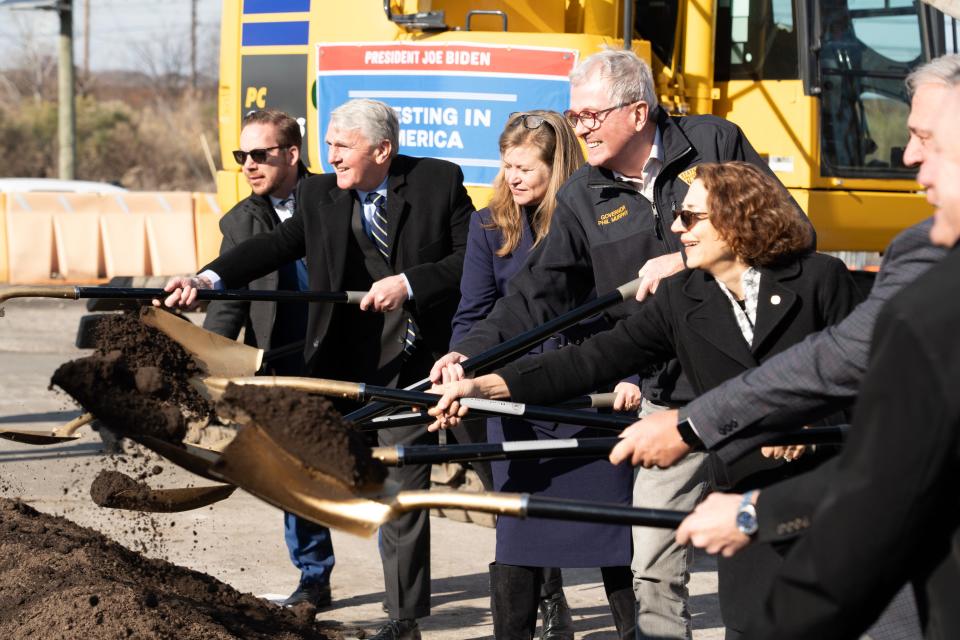Now is the time to renew our commitment to crucial trans-Hudson infrastructure projects
The Northeast Corridor has long been an economic powerhouse for the nation — and finally, we have a federal government in Washington that is investing accordingly, as we clearly saw during last month’s groundbreaking celebration on the West Side of Manhattan for the Hudson Tunnel Project.
When it comes to the Gateway program, though, the whole is really greater than the sum of its parts.
To get the most bang for our infrastructure buck on a new tunnel under the Hudson, we need to ensure that the rest of the Gateway program is fully funded and on track as well. To double ridership, add rail capacity and run up to 48 trains per hour, we need to build the entire Gateway program, from Dock Bridge to Penn Station Expansion in New York.

The Hudson Tunnel Project — the linchpin of the Gateway program, and largest of its 11 projects — just received an additional $3.8 billion from the federal government, building on the crucial investment of nearly $7 billion announced by President Joe Biden earlier this year. This marks the largest federal transit infrastructure grant in history, which will transform commuting patterns for tri-state workers, supercharge economic activity and reduce congestion and carbon emissions. Investing in this critical section of the Northeast Corridor between Newark and New York City will also boost the national economy by offering workers a new and improved commute from their unique communities.
The Hudson Tunnel Project is now on track to get a full funding grant agreement, with construction underway at Hudson Yards Concrete Casing, Section 3 and on the Tonnelle Avenue Bridge and Utility Relocation Project. The point of no return for the Hudson Tunnel project is near, and that is an amazing thing to be able to say.
We have to stay focused on Phase 2 projects
Despite each of these projects being useful in isolation, we need all of them funded and functioning to get the maximum benefit for this section of the Northeast Corridor.
Phase 2 projects will improve service in a number of ways. The Dock Bridge Rehabilitation project will restore the bridge that spans the Passaic River in Newark, which opened to the public in 1935. With a permit from the U.S. Coast Guard, the bridge can be fixed in place, eliminating millions in maintenance costs associated with the movable span and reducing signal problems for Amtrak, NJ Transit and PATH trains that use the bridge.
The Sawtooth Bridges Replacement project will move the Northeast Corridor track to the north and rebuild it as high speed, while also expanding the two-track structure to four tracks and enhancing connectivity with NJ Transit’s Morristown and Montclair lines.
While the Phase 2 projects will require a significant financial investment to be constructed, there is an unprecedented amount of federal funding available. Dock Bridge and the Sawtooth Bridges were just awarded about $300 million and $133 million, respectively.
There's more to Gateway than tunnels: NJ gets $675M from feds for rail work to cut delays
Earlier this year: Biden seeks $700M in budget for Gateway tunnels as confidence in project grows
NJ, NY must act now on even more infrastructure projects
But we have to act now on even more projects. The states and project sponsors need to identify the local share of the funding to take advantage of federal support, which may not be around forever. With an uncertain presidential election less than a year away, and thousands of critical projects across the country in dire need of funding and ready to go — the window of opportunity is short for the states of New Jersey and New York to move on this.
We also still see an urgent need for Trans-Hudson infrastructure. Contrary to popular belief, remote work will not impact working people’s commutes across the river forever. New York and New Jersey remain inextricably connected, and ridership between the two will only continue to increase in the coming decades.
Other projects such as Penn Station Expansion, Portal South Bridge and the Bergen Loops will add needed capacity and provide new connectivity to parts of the region that lack one-seat-ride service to Manhattan, increasing property values.
Altogether, the Gateway program will refurbish century-old infrastructure, reorient and expand the train tracks, enhance connectivity to other transit lines, double capacity and improve safety and reliability.
Regional Plan Association has projected up to a 32% increase in Trans-Hudson transit ridership from pre-pandemic levels by 2050, necessitating a fully-funded Gateway program. Amtrak ridership has already exceeded pre-pandemic levels by as much as 20%. The improved infrastructure will not only meet the demand and projected capacity needs, but better service will likely encourage even more commuters and everyday riders to take transit between New York and New Jersey. Building Gateway in its entirety will improve air quality, encourage companies and residents to remain in the region, and greatly boost the region’s economic potential.
The Gateway program isn’t just a transportation project; it's an investment in a brighter and more resilient future for the workforce that powers our entire region’s economy. No matter how much we agree that the Gateway program is necessary, its full completion is not inevitable. Now is the moment to take advantage of the federal funding awarded and devise a financial commitment plan for Phase 2 projects.
We can’t let such a critical opportunity pass us by.
Carlo A. Scissura is the president and CEO of New York Building Congress. Bette Jane Kowalski is a Union County Commissioner and member of the Raritan Valley Rail Coalition.
This article originally appeared on NorthJersey.com: Gateway project: More work must follow for NY, NJ and the Hudson

